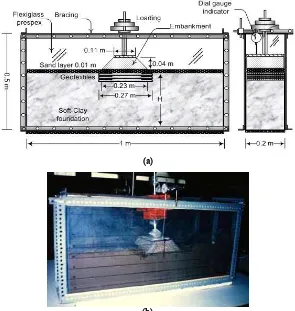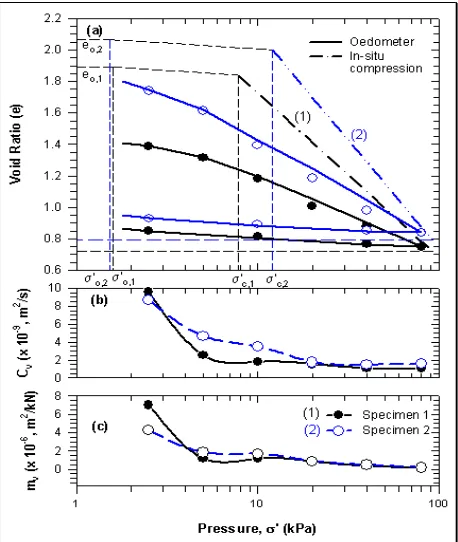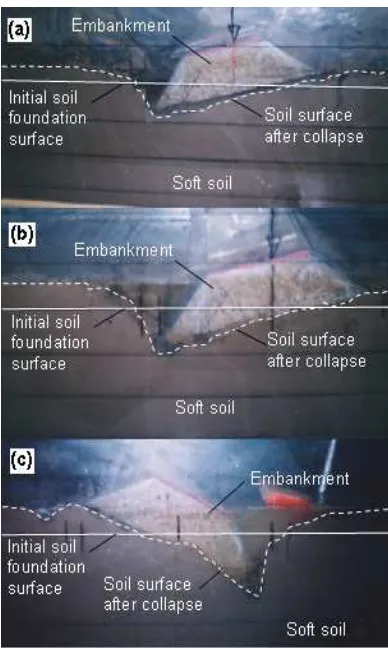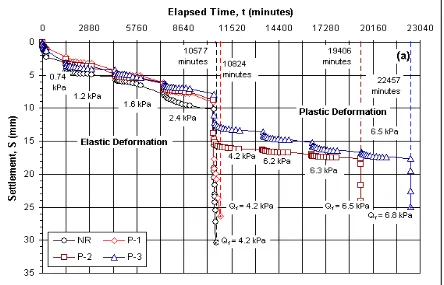Dinamika TEKNIK SIPIL/Vol. 12/No. 2/Mei 2012/ Agus Setyo Muntohar/Halaman : 101 - 107 101
Department of Civil Engineering, Universitas Muhammadiyah Yogyakarta Email: muntohar@umy.ac.id
ABSTRACT
The simple embankment was modelled in laboratory to investigate the settlement behaviour and to evaluate number of reinforcement layers. For the study, two type of reinforcement materials were used that is woven geotextiles and plastic-sack sheets. In laboratory, the dimension of embankment was scaled in 1:10, but thickness of the reinforcement materials was scaled in 1:1. The embankment was designed from a mica-flexi glass to yield a rigid model. The research results show that the settlement of embankment with reinforcement reduced significantly with increasing the number of reinforcement layer. Among the reinforcement used, plastic-sack wastes was effectively to reduce the settlement. Addition of reinforcement beneath the embankment was able to retain and delay the rate of failure
Keywords: settlement, embankment, soft soils, reinforcement, geotextiles, plastic sacks.
ABSTRAK
Model sederhana timbunan diuji di laboratorium untuk mempelajari karakteristik penurunannya di atas tana lunak baik tanpa dan dengan perkuatan geotekstil dan karung plastik dan mengevaluasi jumlah lapisan perkuatan. Model laboratorium timbunan dibuat dalam skala fisika 1:10 , sedangkan ketebalan bahan perkuatan dibuat dalam skala 1:1. Timbunan dibuat dari bahan mica-flexi glass guna memperoleh model yang kaku. Hasil penelitian menunjukkan bahwa penurunan timbunan yang diberi perkuatan berkurang dengan bertambahnya jumlah lapisan perkuatan. Perkuatan dengan menggunakan karung plastik lebih efektif untuk mengurangi penurunan. Penambahan perkuatan dibawah timbunan dapat menahan dan memperlambat laju keruntuhan.
Kata-kata kunci: penurunan, timbunan, tanah lunak, perkuatan, geotekstil, karung plastik.
INTRODUCTION
In recent year, plastic wastes have been a worldwide pro-blem. Plastics were comprised of fibers that could be made from polypropylene (PP), polyethylene (PE), polyethylene terepht-halate (PET), or polyvynil (PV). Environmental issues have dri-ven interest to utilize these plastic wastes as alternative construc-tion material. One promising reuse of these wastes lies in soil re-inforcement. Extensive studies have been reported in the lite-ratures that indicate the use of plastic waste fibers in soil can en-hance the shear strength, tensile strength, durability, load-bearing capacity, and slope stability (Cavey et al., 1995; Consoli et al., 2002; Messas et al., 1998; Ghiassian et al., 2004; Loehr et al., 2000). However, very little research has been done to apply the plastic waste as reinforcement for embankment over a soft soil.
Embankment or earth fill construction is often constructed to serve highway traffic rest on soft subsoil that has low bearing capacity. Theoretically, the embankment will settle subjected to increasing of the load acting on the crest of embankment and the dynamic loading of traffic. One of the methods to reduce the settlement is to place reinforcement beneath the embankment or layered in soft subsoils.
Studies on performance and failure deformation of em-bankment with and without geotextiles reinforcement have been investigated by many researchers such as Jewell (1988), Chai et al. (2002), Bergado et al. (2002), Muntohar (2004). Some resear-ches have been implemented in full scale or field work and microstructure embankment in laboratory. Research conducted by Chai and Bergado (1993) in full-scale model showed that at the acting or service condition, placement of the geogrid re-inforcement beneath of embankment will only contribute lessen factor of safety (FS) of the embankment. Further, the effect on
the reduction of deformation was not significant. However, other researcher, Rowe et al. (1984) denoted a different result that imp-lies the geotextiles reinforcement induces the failure behavior of embankment directly. As stated by Tjandrabirawa et al. (2002), placement of geotextiles beneath the foundation would increase the bearing capacity of the foundation as 241% compared with the unreinforced soil foundation. Some researchers stated that the geotextiles reinforcement acting in soil foundation would be af-fected by geometrical, placement and the materials properties of the geotextiles (Chai et al., 2002; Krishnaswamy et al., 2000; Ut-omo, 2004).
This paper discusses a research result of scaled em-bankment in laboratory over on soft soils foundation with and without reinforcement. The main objective of this study is (1) to study the settlement characteristic of the embankment with and without reinforcement, (2) to evaluate and compare number of re-inforcement layers beneath the embankment.
DESIGN OF EXPERIMENT
Materials Used
Soils
Reinforcement
The geotextiles used in this study is woven type Hate-Reinfox 385250 XT. The allowable tensile strength is about 53 kN/m. The plastic wastes was used in the present investigation were obtained from available polypropylene plastic-sack wastes.
The plastic sack sheets were tested for tensile strength using
Uni-versal Tensile Testing Machine from Hung Ta. The result of ten-sile strength test is presented in Table 1. In this research, number of reinforcement layers was varied 1, 2, and 3 layers beneath the embankment.
Embankment Model
The model embankment was fabricated from flexi-glass. Dimension of the embankment model was designed 0.04 m in he-ight, length of the top was 0.11 m, and length of the foundation was 0.23 m. The flexi-glass embankment was filled with uniform sand whose the unit weight was about γ = 14.4 kN/m3. The em-bankment was placed upon on the soft-clay container. The size of the container was 1 m in length, 0.2 m in width, and 0.5 m in hei-ght as shown in Figure 2. The model was equipped with dial gauge indicator to measure vertical defor-mation when the embankment was loaded. Since scale of the em-bankment model is relatively small (1g), then additional loading was performed to achieve failure.
Figure 1. (a) Particle size distribution of the soil used in this study (b) Plasticity chart
Table 1. Tensile strength test result of the plastic waste used in this study
Parameter Specimens No.
1 2 3
Strain at failure (%) 15.4 15.6 12.3 Tensile strength at failure
(kN/m) 7.56 6.72 6.56
Table 2. Test program in the study
Code Specimens CT LDT
NR Non reinforcement z z
Reinforcement:
G-1 geotextile:: 1 layer | z
P-1 plastic wastes: 1 layer z z
G-2 geotextiles: 2 layers | z
P-2 plastic wastes: 2 layers | z
G-3 geotextiles: 3 layers | z
P-3 plastic wastes: 3 layers | z Note: CT = one dimensional consolidation test; LDT = load-deformation test; z = tested; | = not tested
(a)
Dinamika TEKNIK SIPIL/Vol. 12/No. 2/Mei 2012/ Agus Setyo Muntohar/Halaman : 101 - 107 103 Preparation and Testing Procedure
The tests program for this study is summarized in Table 2. The soft-clay soil foundation was prepared by means filling the soil container with the soil which has liquid limit LL = 72.5% and bulk volume weight γb = 15.8 kN/m3. The soil was
com-pacted to obtain the designed thickness. The clays soil thickness (H) was designed to 0.2 m. Sand layer was deployed 0.01 m over the soft clays foundation as horizontal drain. Then, pre-loading was performed for 3 days to obtain a uniform thickness. The preloading was equivalent with surcharge pressure about 1.0 kPa – 1.5 kPa.
After preloading, soil samples were taken at the a half of soil thickness for consolidation test. Reinforcement, geotextiles and plastic waste, was placed 1 cm beneath the embankment. The vertical spacing between layers was 0.01 m. Length of the reinforcement was 0.02 m longer at each ends than the length of embankment foundation. Number of reinforcement layers was varied from 1, 2, and 3 layers. Embankment model was placed at the center of the soil foundation (figure 2). Additional load was applied incrementally until the embankment collapsed. Each loading sequence was finished after 24 hours or there was no further deformation. For each loading, vertical deformation of the embankment was measured by dial gauge indicator, which instrumented on top of embankment.
Data Analysis
The parameters found from the experiments were vertical deformation of the embankment without and with geotextiles re-inforcement, load at failure, and elapsed time to reach failure. Based on this observed parameter, the data was presented in some graphical presentation as follow: (1) relationship between load and settlement, (2) relationship between settlement and elap-sed time.
RESULTS AND DISCUSSIONS Consolidation behavior
In this study, consolidation and loading test were performed for soil specimens at 0.1 m depth. Table 3 presents parameter observed in consolidation test. According to the results of consolidation test, the overconsolidated ratio (OCR) of the soil specimens are greater than one (OCR > 1). Hence, the soil specimens can be categorized as over consolidated (OC). The degree of compressibility of soft clay soil will be greater if the compression index in laboratory (Cc') have a tendency to
increase.
Table 3. The parameter of consolidation test of soil specimens
Parameter Specimen 1 Specimen 2
σ’c(kPa) 8.7 12.0 compression index, Cr = recompression index, Cc’ = laboratory compression index, eo = initial void ratio
However, situ compressibility was evaluated from in-situ compression index (Cc) values. Based on the Cc values, the
soil specimen can be classified into medium to very soft clay soil since the Cc is greater than one (Cc > 1). The consolidation
behavior of the soil specimens are illustrated in figure 3. The coefficient of consolidation (Cv) and modulus of volume change
(mv) were varied with the applied pressure (σ’). The figure is
alluding to show that clay soil was very compressible soil since the mv value decreased rapidly from 5.7 x 10
-6
m2/kN to 1.5 x 10-6 m2/kN when the pressure was increased from 2.5 kPa to 5 kPa (figure 3c).
Figure 3. Consoliation characteristic of the soft soil foundation
Settlement characteristics of the reinforced-embankment
Figure 4 and 5 depict relationship between surcharge pressure and settlement of the unreinforced and reinforced embankment with geotextiles and plastic wastes respectively. Figure 6 and 7 illustrate the embankment deformation after failure for geotextiles and plastic wastes reinforcement res-pectively. Since the embankment model was designed as rigid model, the embankment rotate to one side of length when the embankment collapsed. Typical of the failure can be identified as local to general shear failure.
The load - deformation curves in figure 4 and 5 show that elastic deformation occurred by increasing of surcharge pressure up to 1.6 kPa. A fully-plastic deformation was attained if the surcharge pressure was greater than 4.2 kPa. According to the load pressure that caused plastic deformation at 4.2 kPa, the set-tlement of the embankment without reinforcement approached 30.4 mm or about 13.2% of embankment foundation (bf = 230
Figure 4. Surcharge pressure and settlement curve for geotextiles reinforcement
Figure 5. Surcharge pressure and settlement curve for plastic wastes reinforcement
In figure 8, embankment settlement decreases with increasing the number of reinforcement layers in soft soil foundation. According to the figure, two layers geotextiles reinforcement is sufficient to reduce the settlement. Additional geotextiles layers slightly reduce the settlement. Different characteristic was observed for reinforced embankment with plasticsack wastes. The settlement is likely to decrease sig-nificantly when the embankment was reinforced with three la-yers plastic wastes. Further lala-yers seem to be a little reduction of the settlement. This characteristic indicated that plastic sack waste was acting effectively as reinforcement materials. How-ever, one should consider durability and endurance of the plastic sack waste which is possible lower than geotextiles materials.
Reducing of the vertical settlement indicated that the tensile strength of reinforcement materials contribute to against the working load. As a result, the embankment can retain further plastic collapse. This behavior was possible to occur owing to thickness of the reinforcement materials was not scaled. Hence, the reinforcement materials were stiffer due to the model. This characteristic indicated that the soil was fully reinforced. This condition was also observed by Jewell (1988). According to the study using finite element method, Bergado et al. (2002) ex-plained that application of a high strength geotextiles could re-duce plastic deformation considerably for soft clay deposit.
Figure 6. Failure of the reinforced embankment with geotextiles
Time and Settlement Characteristics
In this study, the load was applied incrementally every 24 hours until collapsing of the embankment was reached. The elapsed time needed to cause a failure can be defined to indicate rate of settlement of the embankment. Figure 9 illustrates rela-tionship between elapsed time and vertical settlement of the em-bankment with and without reinforcement. For non re-inforcement embankment (NR), the embankment collapsed when plastic deformation started to take place. The time failure was about 7 days (10577 minutes). Different behaviors were ob-served for reinforced embankment. After reaching plastic de-formation state, the embankment can stand until a failure was reached. In general, the embankment with one layer rei-nforcement collapsed at 1 – 2 days after the plastic state. For two and three layers reinforcement, the time of failure range from 4 -6 days and 7 – 9 days after plastic state for two layers and three layers reinforcement respectively. This figure shows that the addition of reinforcement in soft soil enhances the ability of embankment to retain the applied load
Dinamika TEKNIK SIPIL/Vol. 12/No. 2/Mei 2012/ Agus Setyo Muntohar/Halaman : 101 - 107 105 Figure 7. Failure of the reinforced embankment with plastic
wastes
Figure 8. Relationship between settlement and number of reinforcement layers
Figure 10b. Relationship between settlement and elapsed time (b) embankment with plastic-sack wastes reinforcement
CONCLUSIONS
Based on the results and discussion of the research carried out, conclusions can be drawn as follows:
1. Geotextiles and plastic sack wastes reinforcement in soft clay soils contributes a significant reduction in settlement of embankment if compare to embankment without rein-forcement.
2. The settlement of embankment with reinforcement de-crease with increasing of number of reinforcement layers. Both of the reinforcement materials, embankment with plastic-sack wastes reinforcement was effectively to reduce settlement if compare with geotextiles reinforcement. How-ever, two layers geotextiles reinforcement was sufficient to reduce the settlement.
3. Addition of reinforcement beneath the embankment was able to retain and delay the failure rate of the embankment.
ACKNOWLEDGEMENT
The author is greatly thanks to Universitas Muham-madiyah Yogyakarta for the financial support to the research carriedout. Sincere thank also goes to Ir. Dandung Sri Harninto from PT. Tetrasa Geosinindo Jakarta, who has pro-vided the geotextiles. A particular thank goes to Budi Gunawan and Ismi Leviyanda for their help to do some laboratory works.
REFERENCES
Bergado, D.T., Long, P.V., and Murthy, B.R.S. (2002). “A case Study of Geotextiles-Reinforced Embankment on Soft Ground”, Geotextiles and Geomembranes, Vol. 20: 343-365.
Budi, G.S., Susanto, H., and Condro, S.R. (2003). “Evaluasi Penurunan Tanah Liat Dengan Metode Sub-Layer”, Jour-nal Dimensi Teknik Sipil, Vol. 5 No. 1: 14-18.
Cavey, J.K, Krizek, R.J, Sobhan, K., and Baker, W.H. (1995). “Waste fibers in cement-stabilized recycled aggregate base course material”. Transportation Research Record, Trans-portation Research Board, Vol. 1486: 97-106.
Chai, J.C., and Bergado, D.T. (1993). “Performance of Rein-forced Embankment on Muar Clay Deposit.” JournalSoils and Foundations, Vol. 33 No. 4, 1-17.
Chai, J.C., Miura, N., and Shen, S.L. (2002). “Performance of Embankments with and without Reinforcement on Soft Sub-soil”, Canadian Geotechnical Journal, Vol. 39, 838-848. Consoli, N.C., Montardo, J.P., Prietto, P.D.M., Pasa, G.S.
(2002). “Engineering behavior of sand reinforced with plas-tic waste”, Journal of Geotechnical and Geoenvironmental Engineering. Vol. 128 No. 6: 462-472.
Ghiassian, H., Poorebrahim, G., Gray, D.H, (2004). “Soil rein-forcement with recycled carpet wastes).” Waste Manage-ment and Research. Vol. 22 No. 2: 108 – 114.
Jewell, R.A. (1988). “The Mechanics of Reinforced embank-kment on Soft Soils).” Geotextiles and Geomembranes, Vol. 7: 237-273.
Krishnaswamy, N.R, Rajagopal, K., and Madhavi, L.G. (2000). “Model Studies on Geocell Supported Embankments Constructed Over a Soft Clay Foundation.” Geotechnical Testing Journal, Vol. 23 No. 1: 45-54.
Loehr, J.E., Bowders, J.J., Owen, J.W., Lee S., and Liew, W. (2000). Stabilization of Slopes Using Recycled Plastic Pins, the 79th Annual Meeting of the Transportation Research Board, 9-13 January 2000, Washington, D.C.: 1-12.
Dinamika TEKNIK SIPIL/Vol. 12/No. 2/Mei 2012/ Agus Setyo Muntohar/Halaman : 101 - 107 107
matters. In: Maric, Lisac, dan Szavits-Nossan (Eds): Geo-technical Hazards, Balkema, Rotterdam: 573-579.
Muntohar, A.S. (2004). “Penurunan konsolidasi embankment di atas tanah lempung lunak.” Semesta Teknika, Vol. 7 No. 2: 111-125.
Rowe, R.K., MacLean, M.D., and Barsvary, A.K. (1984), “The Observed Behavior of a Geotextiles-Reinforced Construc-ted on Peat.” Canadian Geotechnical Journal, Vol. 21 No. 2: 289-304.
Terzaghi, K., Peck, R., and Mesri, G. (1996). Soil Mechanics in Engineering Practices (Third Edition). John Wiley & Sons Inc., New York, USA.
Tjandrawibawa, S., and Patmadjadja, H. (2002). “Pemodelan Pondasi Dangkal dengan Menggunakan Tiga Lapis Geotekstil di Atas Tanah Lunak.” Dimensi Teknik Sipil, Vol. 4 No. 1: 15-18.




